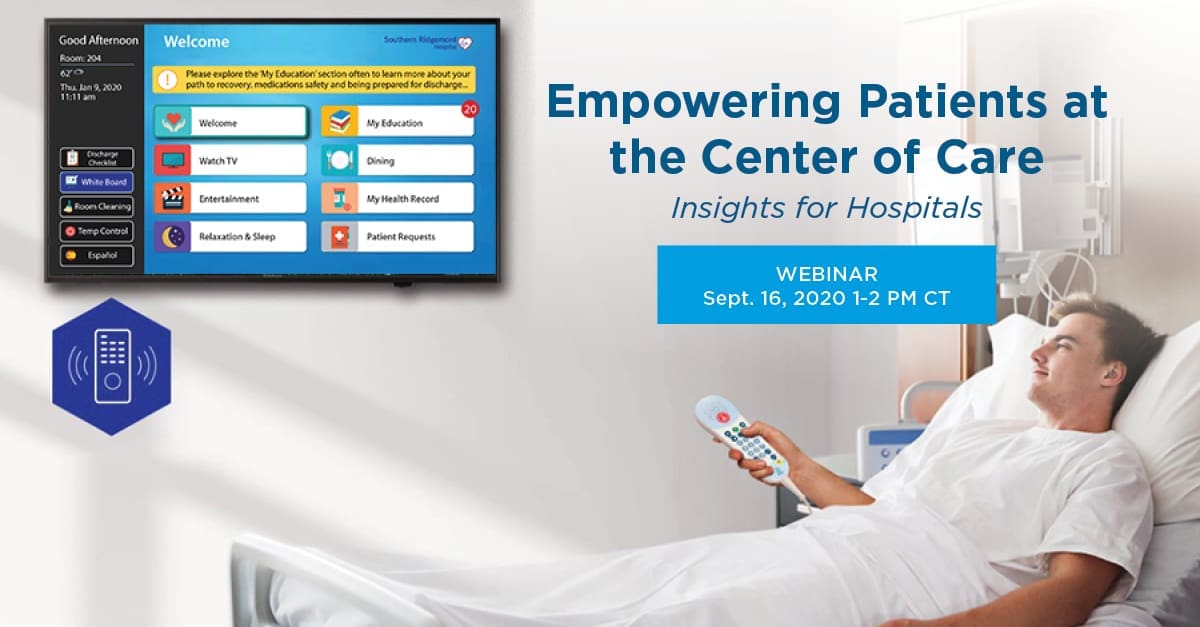The American healthcare industry is known for many things—sadly, a pleasant patient experience isn’t always them. In large part, that’s because many hospitals have yet to adapt to meet the expectations of patients who are increasingly discerning, demanding, and technologically savvy consumers.
The industry has been slow to recognize the influx of consumerism, and even slower to adapt to it.
At no time has that message been more clear than through the COVID-19 pandemic It is teaching hospitals some poignant and painful lessons about how to deliver care to a healthcare consumer-patient market. One of those lessons is this: interactive patient engagement is no longer something that’s just nice to have.
It’s a must-have.
PATIENTS, CONSUMERS, AND THE 3 C’S
Words have meaning. They can impact how we think, act, and treat others. The word patient is derived from the Latin root word “patientem,” meaning one who is long-suffering.
Hospitals have come to expect that because individuals are in need, they will (and must) be patient. Ever sat with a family member in the hospital? The concept of “hospital time” is a real thing; waiting, not knowing what’s next, not having information, and with no control over the situation. The nurse or physician might round at 10 am or 2 pm; the MRI you were expecting before breakfast still hasn’t happened by late afternoon, and you still don’t know the recovery progress from yesterday’s labs. It’s no wonder: clinical staff are stretched thin; without an automated, digital way to connect patients directly to the answers to these questions, the patient is at the mercy of others.
As Forbes notes, this approach seems paradoxical to the consumer-centric approach taken by every other industry in the country:
“To what extent have organizations that deliver on health unintentionally eroded or misconstrued the experience by seeing an individual as a condition and not a person – a patient instead of a consumer? Could it be that in seeing someone as a patient we have created an unconscious treatment bias loop that nurtures a “victim” mindset and a passive approach to health?”
Poll after poll demonstrates that Americans aren’t happy with the current way that hospitals operate. Today’s patients want to be treated as consumers. They demand a personalized, simplified, and connected experience that leverages interactive patient engagement technology to deliver the 3 C’s:
- Convenience
- Control
- Communication
CONVENIENCE
Providing excellent care is no longer good enough. Patients also crave convenience in the healthcare system. That shouldn’t be surprising; we live in a world where we have immediate, 24/7 conveniences. Think Amazon, Instacart, Netflix.
In 2019, NRC Health’s Market Insight surveyed more than 220,000 healthcare consumers. Researchers found that over half of those surveyed said that convenience and access to care are the two most important factors in their decision-making process. In fact, “80% of patients reported that they switched providers for ‘convenience’ factors alone.”
Now that they have more choices than ever, the patient has leverage in the relationship. If an individual is not receiving the care experience they want, they can simply embrace consumerism and go someplace else that offers convenient technologies such as:
- Digital access to their health record and care plan – From onboarding to discharge, patients require a streamlined, immediate access to their own health records, education, and care plans. Engaged and educated patients are more likely to understand their health issue and to then follow the prescribed care. This leads to:
- Better health outcomes
- Reduced readmissions
- Improved patient satisfaction
- Patient-centric technology – Although patients are more tech savvy than ever, they still want to use intuitive platforms that are:
- User-friendly
- One-touch
- Operate in real-time
- Accessible 24/7/365
Even little conveniences go a long way towards improving patient satisfaction. Today, consumer experience and satisfaction is the number one goal for the healthcare industry.
CONTROL
A trip to the hospital can be an overwhelming experience. The patient is told what to do and when to do it. And the necessary COVID precautions have made it so patients can’t even have a say in who visits them during their hospital stay.
To give back a small semblance of control, hospitals can allow their patients to have a say over their room comfort. According to Stacey Chang, executive director of The University of Texas at Austin’s Design Institute for Health, “Giving patients control of their experience is a really big deal because it empowers them and allows them to play a role in their care.”
Interactive patient engagement platforms like Sentrics’ empower patients to make a hospital room their own without ever having to leave their bed. This can be done through a number of interactive features, including:
- Adjusting their own room temperature
- Accessing their interactive care whiteboard
- Raising or lowering window blinds
- Turning down the lighting in the room
- Drowning out hallway noise and chatter with relaxing sounds and ambient music
- Ordering a meal
- Requesting immediate housekeeping services
- Asking for a chaplain visit
- Reading discharge planning instructions
Just the ability to control their space can make a significant difference in patient quality of life. While these may seem like inconsequential things, to the patient who has little to no authority over their healthcare treatment and outcomes, it can mean the world.
COMMUNICATION
The time that nurses and doctors have to interact with patients is limited. According to Medical Economics, “The average physician sees around 21 patients in a single day—leaving a total of just 10-15 minutes per patient.” This doesn’t leave a whole lot of time for a conversation surrounding their health treatment.
When they first arrive, patients are bombarded with a deluge of information, much of which is immediately forgotten. On the flip side, when treatment is finished, they often return home without a clear comprehension of their diagnosis and aftercare treatment plan.
This lack of communication leads to poor health outcomes and patient dissatisfaction.
Forward-thinking hospitals are turning to technology to fill in the communication gaps and push a patient-centered communication strategy. This includes:
- Digital signage – Allows care teams to display important health information in common areas such as alerts, community messaging, and population health tips. By providing vital health information to both patients and visitors, hospitals increase patient safety and reinforce their focus on creating a positive, health-centric environment.
- Health education videos – When nurses are stretched thin for time, they can’t fully review all aspects of a patient’s care plan with the patient during rounding. Digital health videos, automatically delivered to the patient room TV, help educate and inform patients during every phase of their stay, whether onboarding, treatment, or discharge.
- Digital whiteboards – The more knowledge that patients have about their treatment and care team, the happier they are. In-room digital whiteboards give individuals increased access to their health data. This provides them with critical care information, which enhances communication between patients and staff.
- Messaging and feedback – Patients will be far more tolerant of busy staff when they have more ways to speak to experts, alert their care team, or get help they need as soon as they need it. Giving the patient access on the TV to frequent interactive surveys allows hospitals to address issues and de-escalate situations before they can get out of hand.
A tech-enabled health record strategy empowers patients to take an active role in their care without being wholly reliant on nurses and doctors to provide critical information.
BENEFITS OF MEETING THE 3 C’S
Until now, many hospitals were hesitant to link patient care to consumerism. They may have feared that by commoditizing care, by treating people as objects, they would lose compassion.
Today, it’s more important than ever for hospitals to treat patients as consumers.
How?
By putting their relational and engagement experience at the center of their practice. Patients want to be heard, empowered, and have at least some power over their treatment and care experience. To be truly “patient-centered” requires committing to put the patient at the center of their care. The interactive patient engagement platform is the single platform that achieves that. Without a platform specifically centered around the patient’s use, a hospital will be hard-pressed to truly fulfill the definition of patient-centered care delivery.
The hospitals that do embrace this patient-centered mindset will have a competitive advantage over other facilities. For instance, Northern Westchester Hospital leveraged Sentrics E3 interactive patient technology to create a patient-centered, consumer care process.
The results are impressive; the hospital’s ratings skyrocketed across the board:
- Room quietness increased 15%
- Staff responsiveness increased 12%
- Medication communication ratings gained 11%
- Nurse communication scores improved by 8%
- Discharge planning scores improved by 6%
- Patient ratings of the hospital improved by 9%
Northern Westchester expanded their patient education and engagement capabilities by putting health education in patients’ hands. They provided patients with more convenience, greater control, and better communication.
This improved patient experience, leading to superior health outcomes.
Sentrics E3 – LEVERAGING TECHNOLOGY TO IMPROVE PATIENT OUTCOMES
With the ever-growing emphasis on engaging consumers in their wellbeing, platforms must offer access to effective, intuitive tools that engage patients right from their bed.
Consumers have specific needs, which can’t be met by the hospital’s business-centric platforms. Hospitals must instead turn to consumer-based platforms like Sentrics E3 solutions, which offer a personalized, data-driven ecosystem for the consumer. This includes:
- Customized patient education
- Comfort controls
- In-room entertainment
- Enhanced communication with family and staff
Sentrics’ platform is the single tool needed to start treating patients as consumers. With it, the hospital can drive patient satisfaction and outcomes and empower your hospital to achieve operational efficiencies. With it, you can fulfill the 3 C’s and improve the patient experience.
Learn more about the three patient demands you can’t ignore, and how to restore patient confidence in a post-COVID world.
Sources:
Siegel + Gale. Simplicity Index. https://simplicityindex.com/2018/region/united-states/
Online Etymology Dictionary. Patient Origin and Meaning. https://www.etymonline.com/word/patient
Forbes. Why Treating Patients As Consumers Can Improve The Healthcare Experience. https://www.forbes.com/sites/dangingiss/2019/07/09/why-treating-patients-as-consumers-can-improve-the-healthcare-experience/#4bf6cc9f63a1
Prophet. The Current State of the Patient Experience.
NRC. 2019 Health Care Consumer Trends Report. http://nrchealth.com/wp-content/uploads/2018/12/2019-Healthcare-Consumer-Trends-Report.pdf.
NCBI. Improving health outcomes through patient education and partnerships with patients. https://www.ncbi.nlm.nih.gov/pmc/articles/PMC5242136/
Becker’s Health IT. Interactive Patient Education Reduces Readmissions, Increases Satisfaction: Kaiser Permanente Panorama Hospital Case Study. https://www.beckershospitalreview.com/healthcare-information-technology/interactive-patient-education-reduces-readmissions-increases-satisfaction-kaiser-permanente-panorama-hospital-case-study.html
Modern Healthcare. Redesigning hospitals with patient experience in mind. https://www.modernhealthcare.com/article/20171111/NEWS/171109884/redesigning-hospitals-with-patient-experience-in-mind
Medical Economics. Want better outcomes? Improve patient communication. https://www.medicaleconomics.com/view/want-better-outcomes-improve-patient-communication
Business Insider. Sentrics E3 Interactive Solution Helping Improve Patient Experience at New York Hospital. https://markets.businessinsider.com/news/stocks/allen-e3-interactive-solution-helping-improve-patient-experience-at-new-york-hospital-1028314909#



